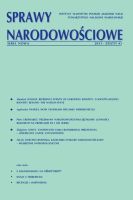Tantryczne ciało rosyjskiego prezydenta – oświecony umysł Czyngisydów. Polityka i nacjonalizm w buddyzmie buriat/mongolskim
The tantric body of the Russian President – Chingisids’ enlightened mind. Politics and nationalism in Buryat / Mongolian Buddhism
Author(s): Zbigniew SzmytSubject(s): Cultural Essay, Political Essay, Societal Essay
Published by: Instytut Slawistyki Polskiej Akademii Nauk
Keywords: Buddhism; Buryatia; Mongolia; nationalism; tradition; identity
Summary/Abstract: This paper is devoted to the role of Buddhism in the construction of ethnonational identity in Buryatia and Mongolia. On the case of the phenomenon of deification of Russian presidents by Buryat lamas I have analyzed: historically conditioned compounds of Buddhism and politics of the Mongolian groups, the role of Buddhism in ethnic mobilization in Buryatia and Mongolia after the fall of Communism and features of ethnonational model of Buddhism in two neighboring regions. In post-socialist period Buddhism was involved in ethnonational political projects. As a result, an attempt was taken to restore the monastic model of Buddhism, which had functioned in the pre-revolutionary period. Local peculiarities of Mongolian Buddhism were reinforced in order to produce the difference between the (national) Mongolian/Buryat and Tibetan Buddhism. In Buryatia, Buddhism became a distinctive element used for ethnic differentiation of Buryats – in opposition to the Orthodox Russians. In Mongolia, traditionalist position of Buddhism was opposed in some way to Christianity, the various factions of which are distributed together with “agendas of modernity” from Western countries. In tantric union with the president Buryat lamas produce harmony between two national identities: Russian – civic and Buryat – ethnonational. Deification of the state power and giving it the attributes of loving femininity is a practice obliging the authority to generosity, which is attributed to the White Tara. It is a strategy of the weak, who agree to a game of domination, but they try to define its rules themselves. Looking more broadly it can be said that the Buryats as a national community appeared just as a result of this fusion with the Russian power. because of this they were separated from the pre-national family of Mongolian peoples. Mongols, for similar purposes use Chingis Khan identified with the Buddhist form of Vajrapani. As a result, nationalist narrative is set to famous past, but uses the ‘eternal’ values, achieves harmony of all its elements.
Journal: Sprawy Narodowościowe
- Issue Year: 2013
- Issue No: 43
- Page Range: 87-105
- Page Count: 18
- Language: Polish

